Overview of traditional festivals
Festive activities are living museums in which typical cultural values of the nation have been preserved for centuries.
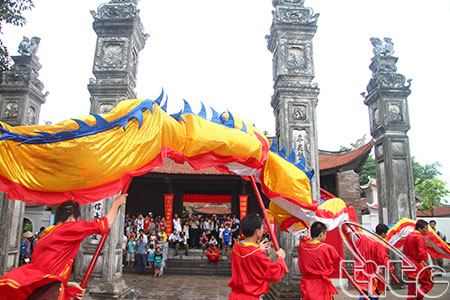

Formation and meaning of traditional festivals
Traditional festivals constitute a form of cultural activities, a spiritual product which the people have created and developed during the course of history. From generation to generation, the Vietnamese people preserve the fine tradition of “remembering the source while drinking water.” Festivals are events which represent this tradition of the community as well as honour the holy figures named as “gods” – the real persons in national history or legendary persons. The images of gods converge the noble characteristics of mankind. They are national heroes who fought against foreign invaders, reclaimed new lands, treated people, fought against natural calamities, or those legendary characters who affect the earthly life. Festivals are events when people pay tribute to divinities that rendered merits to the community and the nation.
Festivals are occasions when people come back to either their natural or national roots, which form a sacred part in their mind.
Festivals represent the strength of the commune or village, the local region or even the whole nation. Worshipping the same god, the people unite in solidarity to overcome difficulties, striving for a happy and wealthy life.
Festivals display the demand for creativity and enjoyment of spiritual and material cultural values of all social strata. Festivals become a form of education under which fine traditional moral values can be handed from one generation to the next in a unique way of combining spiritual characters with competition and entertainment games.
Festivals are also the time people can express their sadness and worries in a wish that gods might bestow favour on them to help them strive for a better life.
 Process of festivals
Process of festivals
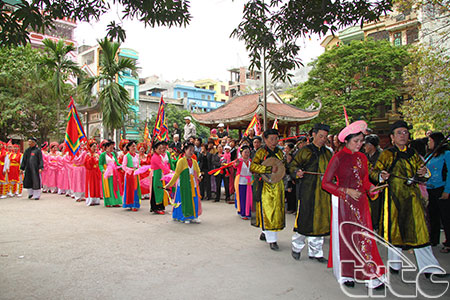
Generally speaking, every festival will include the following three steps:
Preparation: The preparation work is divided into two phases: prior to the coming festive season and in the immediate time before the festive day. The preparation work for the coming festive season starts right after the previous festival comes to an end. When it is coming to the festive day, people need to check the worshipping objects, attires, decoration, and cleaning of the worshipping place and statues.
The festive day: Many activities take place, including rituals of procession, incense offering, and rejoicing games, among others. They form the most important and significant part of any festival. These activities also play a decisive role in attracting tourists and deciding the timing of the festival itself.
The ending of the festival: The organization board expresses their thanks to all festival goers and closes the worshipping place.
 Time for festivals
Time for festivals
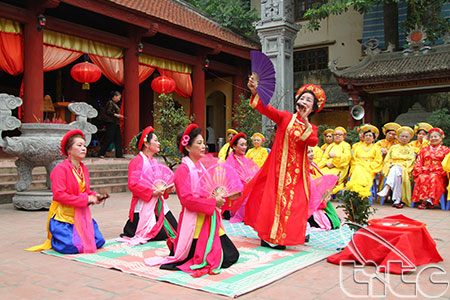
In Viet Nam festivals often take place during the three months in spring and in autumn when people have a lot of leisure time. In addition, the climate in spring and autumn is especially suitable for holding festivals and for festivals goers to enjoy.
Festival rituals
Festivals require many compulsory rituals, which are carried out in a strict order from the preparation to the ending of a festival. In general, a festival has the following rituals:

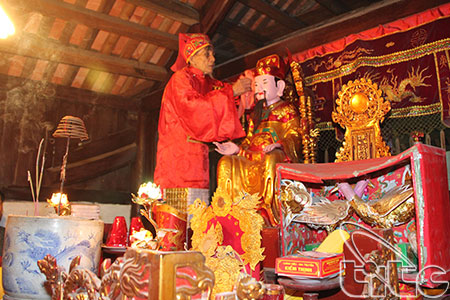
Statue washing rite is performed at mid-night of the day before the festival. This rite is preceded by a ceremony of water procession in some places. A ceremony to inform gods must be held prior to this statue-washing rite.
Next is the rite of wearing hats and costumes for gods’ statues or putting them in their worshipping tablets if gods have no statue. After that, the statues of gods (or worshipping tablets, even costumes) are put in the palanquin, ready for the procession on the opening of the festival.
Procession ritual: A festival often includes the procession of gods, tutelary gods, royal order and water, of which the first and fourth rite are most popular. The content and meaning of the procession ritual vary from festival to festival with regard to the object of procession, its organization and participants. The procession of gods and water processions are usually carried out prior to the opening and closing ceremonies of the festival accordingly.
Festivals, as mentioned above, are to honour holy figures, i.e. gods or divinities to whose temples and shrines are dedicated. Very often a festival takes place in the courtyard of the village’s communal house which is spacious and convenient for the conduct of liturgical processes and rejoicing activities. As such, the ritual of god procession is held along the route from their places of worship to the place of liturgy. At the end of the festival, another procession will bring gods’ statues back to their temples. After the procession ritual are the ritual of presenting offerings to gods and the opening of the festival. In many festivals, a procession of the oration dedicated to gods is held every day. Each day a different oration is used.

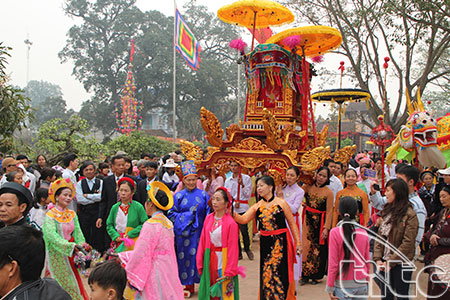
In traditional festivals it is required that participants in the procession ritual must be men above 18 years old who are selected carefully on the basis of their physical strength and good ethics. Women can join the procession group in such festivals as Phu Day or Ha Loi which dedicate to goddesses. Anyone who is chosen to become a member of the procession group must consider it his/her own honour and his/her family.
On its way, each procession bears its own symbol. People beat drums and gongs (formerly firecrackers were used) to signal the departure of the procession.
On the closing day of the festival, a final ritual is held with all processes required.
Rice cooking competitions (thi thoi com)
During Tet, a number of villages in northern and central Viet Nam hold cooking contests that may sound simple, but follow strict and complex rules: Cooking in the wind and rain. Tu Trong Village, Thanh Hoa Province has a temple dedicated to the 11th century warrior Le Phung Hieu.

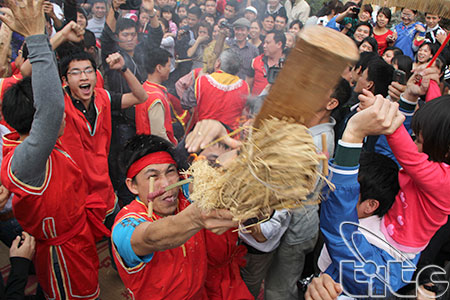
During the temple's weeklong festival the first week of Tet, villagers hold culinary competitions: cooking ordinary rice in water, steaming sticky rice and making rice cakes.
Contestants cook in the open air while in a bamboo boat floating on the village pond. Charcoal, the usual fuel, is prohibited. Instead, each competitor receives some dried sugar cane, which burns only with difficulty. The challenge increases if it is windy and raining. Each contestant must set her rice pot in exactly the right place to take advantage of the wind and avoid extinguishing the fire.
The competition begins precisely at dawn. Hundreds of boats are tied up along the pond bank since as many as 200 young women may participate.
After a salvo of drumbeats, competitors step into their boats, bringing along cooking tripods, rice pots, some damp straw and fuel. They row to the centre of the pond, make a fire and wash the rice.
A second salvo of drumbeats sounds, punctuated by three final beats, the competition starts. The cooking may be done in one pot after another or by using all pots al the same time. The tiny, light boat sways with the competitor's every movement, keeping the craft stable while cooking is like performing a circus act. The competitor who finishes first wins, but quality also counts. People from many villages watch from the pond bank, mothers who have trained their girls for months impatiently wait for the results of their efforts. Other women take advantage of the occasion to look for prospective daughters-in-law who are both good cooks and can also face difficulties with calmness.
Contests for boys and girls villagers in Chuong Village of Ha Noi organise similar competitions separately for boys and girls. Female participants must cook rice on the ground while simultaneously carrying a six-to seven-month-old baby from another family on her hip. She must console the infant when he or she cries. At the same time, she must prevent a toad from jumping out of a chalk circle drawn around her. The competition is all the more difficult because the spectators, especially children, take every opportunity to tease the baby.
The contest for boys is no less rigorous. Each boy must stand ready with all the necessary items (rice, water, matches and firewood) on a light boat moored the pond bank. At a given signal he paddles with his hands to the opposite bank, where a row of pots is placed on tripods. He must stay in his unmoored boat while cooking the rice on the bank. The least loss of balance tosses him over into the water.
In Tich Son Village of Vinh Phuc Province, a cooking competition takes place on the morning of the fourth day after Tet. The finished rice must meet particular criteria of taste and consistency. Contestants use two pots. First they boil the rice in a copper pot over the fire. Once the water boils, they pour both the rice and water into an earthen pot and cook the rice over charcoal until done.
Spinning Tops (con quay)
In summertime, groups of children often play with tops along Ha Noi’s streets and alleys. Their enthusiasm and happy laughter attract an audience, old and young, and remind older viewers of their younger days. The folk pastime of top spinning still charms city children despite the popularity of modern games such as bowling, skateboarding, billiards and video games.

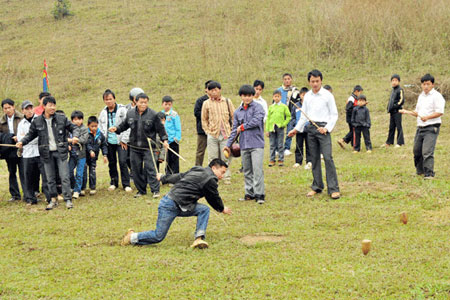
In the countryside, most children make their own tops out of guava, jackfruit, or longan wood. Sometimes they fashion tops from buffalo horn, though there tops are rare because horns are harder to obtain and more difficult to shape. City children frequently use wood scraps left from making furniture to fashion their tops. To Tich Street in Ha Noi’s Old Quarter is famous for trading tops. A top has three parts: the head, body and nail. The head is shaped into a cylinder. The body is a sphere; the string is wound around its upper part. The nail must be accurately fixed into the bottom point of the top. Children in the countryside make strings from dry maize leaves; Ha Noi children often use parachute string or cord.
The simplest way to spin a top is to “drop” it. The player uses his or her ring finger and little finger to press the cord or string against the nail at the knot. He or she holds the top firmly with the thumb and two remaining fingers so that its nail points upwards. Then he or she “drops” the top in three rapid steps: first, pushing the top forward while turning the wrist to point the nail downwards, then releasing the top; and rapidly pulling the string.
 Once the top is spinning, players can use the string to move the top in the desired direction. When the top wavers, the player runs the string against the nail and pulls powerfully in the direction the top is turning. This keeps the top spinning longer.
Once the top is spinning, players can use the string to move the top in the desired direction. When the top wavers, the player runs the string against the nail and pulls powerfully in the direction the top is turning. This keeps the top spinning longer.
Although tops are among the simplest of toys, excited children spinning tops create one of Ha Noi’s most vivid and boisterous games.
Bamboo Jacks (choi chuyen)
This girls' game (chơi chuyen) includes ten thin, well-sharpened, round bamboo sticks and a ball, which traditionally is a fig, a miniature variety of eggplant, a small rock or a clod of clay.

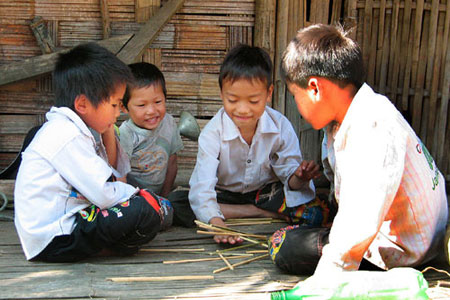
These days, tennis balls are becoming more popular as a substitute. The player tosses the ball into the air. While the ball is in the air, she must quickly pick up the sticks and then catch the ball.
Players often recite a singsong nonsense rhyme: "Cai mot... Cai mai... Cai co… So mang... Thang chang... Con chit... Ngam nga... Ngam nguyt... Chuot chit... Sang ban doi…"
In the first round, the player picks up the slicks one by one. Next, she gathers two sticks at a time, and so forth up to ten. In these stages she plays with only one hand. The girl picks up sticks and catches the ball while reciting the rhyme. Meanwhile, her face reddens and her eyes become intense as she performs in front of her friends.
 The peak of the game is the last, most animated stage with all ten sticks in a bundle. During this stage, the player losses the ball and then transfers (chuyen) the pack of sticks from one hand to the other. She must successively switch the bundle, first once, then twice, then three or even more times before catching the ball. The hands of a girl playing chuyen open and close like small, nimble butterflies. If a player's hands are not swift or if her eyes are not sharp, or if she fails to coordinate the two, she will lose her turn. The game will pass to the next girl. Playing chuyen warms up the body and creates a lot of fun. During summer or autumn, small girls play it everywhere, from the shade of a village banyan tree to a deserted market stall.
The peak of the game is the last, most animated stage with all ten sticks in a bundle. During this stage, the player losses the ball and then transfers (chuyen) the pack of sticks from one hand to the other. She must successively switch the bundle, first once, then twice, then three or even more times before catching the ball. The hands of a girl playing chuyen open and close like small, nimble butterflies. If a player's hands are not swift or if her eyes are not sharp, or if she fails to coordinate the two, she will lose her turn. The game will pass to the next girl. Playing chuyen warms up the body and creates a lot of fun. During summer or autumn, small girls play it everywhere, from the shade of a village banyan tree to a deserted market stall.
Kites that make music (dieu sao)
Kite flying is popular throughout the year in Viet Nam but especially so in summer. People of different ages make kites of many shapes, sizes and materials.

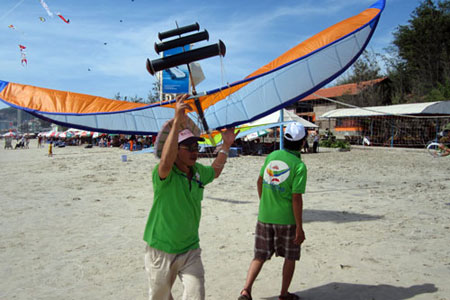
Children's kites are often small, simple and covered with paper, while adults' kites may be more complex, cloth-covered, and feature one or more wind flutes that play melodies as the kites fly.
A typical adult's kite has four parts: the body, the steering string, the flying string and flutes. The frame is made of the smooth outer bamboo stalk and is well polished. Kite-makers shape bamboo straps into a crescent two to three metres long and one metre wide. After that, they cover the frame with pieces of cotton cloth or carefully glued paper. If one half of the kite is heavier than the other, the steering string will help balance it. This string also serves lo direct flight and protect the kite wings from breaking if the wind is too strong. The flying string is also made of bamboo and can be as long as 100m to 150m. Young bamboo straps the size of chopsticks are tied together, then boiled in water or even in traditional Chinese medicine and salt so that the string becomes soft and flexible.
Kites not only attract people by their shapes and colours but also by their flutes. Flutes of different sizes and materials can make the sound of birds, car horns, gongs or music. The mouth of the flute must be skillfully carved so that it can properly receive the wind and create the desired sound.
Today, villagers build more sophisticated kites in the shape of phoenixes, butterflies and dragons. They replace thick bamboo strings with thinner bamboo or plastic rope. Modern kites are very light and cost little since the materials to make them are readily available.
 People often fly kites in the late afternoon as the sun begins to set. Normally, two people fly one kite. One person holds the flying string while the other takes the kite and runs into the wind until the wind lifts the kite.
People often fly kites in the late afternoon as the sun begins to set. Normally, two people fly one kite. One person holds the flying string while the other takes the kite and runs into the wind until the wind lifts the kite.
The two may keep the kite high in the sky from day to day, even from summer to autumn.
Every year, kite-flying competitions take place in many northern and central provinces. The rules vary from place to place. In general, the most beautiful kite with the most interesting flute melodies wins. However, Quang Yen Town (Quang Ninh Province) holds a kite-fighting competition: regardless of design, kites that hit or break other kites win.
The game of squares (O an quan)
Either boys or girls, usually age's seven to ten, play the two-person game of O an quan (literally "Mandarin's Box"). They draw a rectangle on the ground and divide it into ten small squares called "rice fields" or "fish ponds.

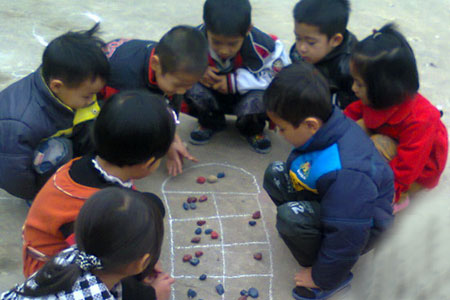
"They also draw two additional semi-circular boxes at the two ends of the rectangle, which are called"mandarin's boxes," hence the game's name. Each person has 25 small pebbles and a bigger stone.
Each player places the stone in one of the mandarin's boxes and five small pebbles in each of the other squares (see diagram above). Then the game begins. The first player takes up the contents of one square on his or her side of the board (but not a mandarin's box) and distributes the pebbles one by one, starting with the next square in either direction. (Since each square contains five pebbles at the beginning, the first move will distribute five pebbles to the left or right).
After the last pebble is distributed, the player takes the contents of the following square and repeats the distribution process. But if the following square is one of the mandarin's boxes, the turn ends and passes to the other player.
If the last pebble falls into a square that precedes one empty square, the player wins all the contents of the square following the empty square and removes these pebbles from the board. If this square is followed by another empty square, the player wins the contents of the square after that, and so on. However, if there are two or more empty squares in a row, the player loses his or her turn.
 Once a player has taken pebbles from the board, the turn is handed to the other player. If all five squares on one player's side of the board are emptied at any time, that player must place one pebble he or she has aside back in each of the five squares so that the game can resume.
Once a player has taken pebbles from the board, the turn is handed to the other player. If all five squares on one player's side of the board are emptied at any time, that player must place one pebble he or she has aside back in each of the five squares so that the game can resume.
The game continues until the two mandarins' boxes have both been taken. At the end of the game, the player with more pebbles wins, with each of the large stones counting as ten points. If each player retrieves an equal number of points, then the game is a tie. O an quan remains deservedly popular among older children since it requires good counting skills and forethought in order to win.
Cat and Mouse Game (meo duoi chuot)
Each game requires between seven and ten people. They stand in a circle, hold hands and raise their hands above their heads. Then they start singing the song.
Please come over here
Hand in hand
Stand in a large circle
The mouse will run through the hole
The cat will run after it
The mouse tries to run as fast as possible
But it can't escape
Then the mouse will act as the cat and chase the cat, which is now the mouse.

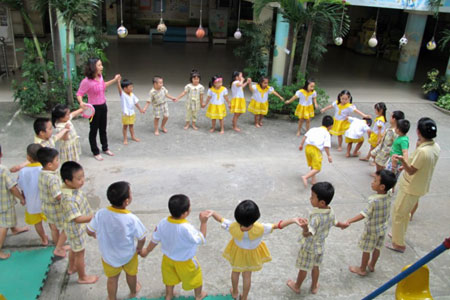
How to play the game:
Each game requires between seven and ten people. They stand in a circle, hold hands and raise their hands above their heads. Then they start singing the song above. One person is chosen as the cal and another as the mouse. These two stand in the middle of the circle and lean against each other. When the others sing the last sentence, the mouse starts to run, and the cat must run after it. However, the cat must run in exactly the same route and manner as the mouse. The cat wins the game when it catches the mouse. Then the two exchange roles. If the cal runs into the wrong hole, it will be dismissed from that round.
If it fails to catch the mouse in a certain period of time (usually from three to five minutes for kindergarten-age children) it will exchange its role with the mouse. The game will then continue.
The Game of the Dragon-Snake (rong ran)
A large group plays the children's game rong ran (dragon-snake). In One person sits on a small hill or some location above the other players; he or she acts as the doctor. The other children stand in a line, holding each other's belts to form the body of the dragon-snake.


The dragon-snake approaches the doctor. The following dialogue occurs between the doctor and the head of the line:
- Where are you going, dragon-snake?
- I’m searching for medicine for my son.
- How old is he, your son?
- He is one year old. - The doctor is not well.
- He is (two, three, four, five... repeated each time) years old. - The doctor is not well.
The dialogue continues until the dragon-snake says:
- He is ten years old.
Then the doctor answers:
- All right, the doctor is well.
With this, the doctor stands up and says:
- Give me your head
- Nothing but the bones
Responds the dragon-snake
- Give me the body.
- Nothing but the blood.
- Give me the tail.
- Pursue at will!
At this, the doctor flies into a rage and attempts lo catch the child who represents the tail of the dragon-snake. The head of the line stretches his or her arms to bar the doctor while the dragon-snake tries to make a circle. If the dragon-snake succeeds in rolling into a circle before the physician can touch the tail, it wins. On the contrary, if the doctor catches the tail of the dragon-snake, the entire group loses the game. All losers must stretch out their hands, palms downwards, to the winner, who slaps them one after another.
Throwing a sacred ball through the ring (nem con)
Each ethnic group in Viet Nam has unique ways of celebrating Tet. The Tay people of Cao Bang and Lang Son Provinces have a special Tet game that not only ushers in the spring but also serves as a matchmaker.

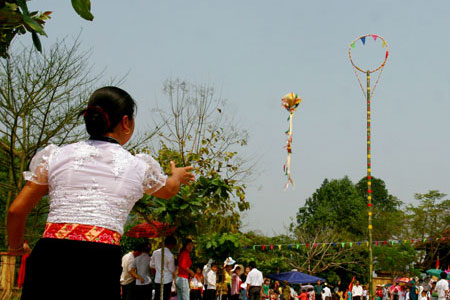
According to Tay legend, Pia, an orphan, war poor and lonely. Discouraged with life, he went to the forest and gathered pieces of fruit to throw around. One time, he threw a fruit so hard it flew straight to heaven, where a fairy caught it. The fairy flew down to the earth to play with Pia. Before long, they fell in love and became husband and wife.
The people of the mountain village believed that the fruit had brought Pia happiness. To celebrate this story, young men and women toss balls (nem con) each year from the third day of Tet until the end of the first lunar month.
Players gather on a level field where villagers have planted a tall bamboo tree. A bamboo ring about 30-40 cm in diameter hangs from the tree. Gaudy fabric covers the balls, which the makers have stuffed with rice grains (representing food) and cotton seeds (clothing) along with their hidden desires. A multicoloured tassel decorates the balls.
According to tradition, before playing, the Tay people first prepare a tray of food, which they take to the field and offer to the Sky and Earth. Two balls and a bamboo ring on the tray represent vitality and virtue. The festival leader, who must have high status, prays to the Sky and Earth lo brings rain so that the community will have a good harvest. After this ceremony, the leader tosses the two balls high into the air. Everyone competes to catch them, signaling the beginning of festivities.
At that point, each family may throw its own household ball through the bamboo ring for good luck. Naturally, some balls do not make it through on the first try. The owners may try over and over until they are successful.
The festival leader closes with a prayer for a good planting season, then slashes the ball open and distributes seeds to everyone. These seeds bring good luck and will sprout quickly because they unite the forces of am and duong (yin and yang) in the warmth of women's and men's hands. Everyone receives the holy seeds of the Sky, the Earth and Humanity with the belief and hope that their crops will increase, people will prosper and the entire village will have sufficient food, clothing and happiness. For this reason, the ball game is a major feature of Tay tradition.
Releasing pigeons (tha chim)
A long with other traditional festival games, releasing pigeons has attracted numerous participants since the distant past. Some villages including Tam Giang and Hoan Son villages in Bac Ninh Province still maintain the tradition.

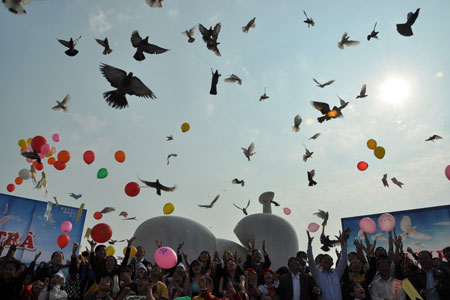
Every year, Hoan Son and Tam Giang villagers organise bird-releasing festivals in the early summer and mid autumn during the third and the eighth lunar months. Each family raises two or three flocks of pigeons. Judges stipulate that each flock in the spring contest may have ten pigeons but only eight in the autumn. The contests are open to anyone-not just Bac Ninh residents. Bird lovers use these occasions to exchange experiences and learn from each other.
The Judges consist of the trich ha, who distributes numbers to participants and then call the numbers for the birds' release, and the trich thuong, who observes the arrangement of birds in the sky to determine the winner, a flock of birds flies beautifully when all their heads huddle together. Seen from the ground, they look like an arrow disappearing on the horizon.
"Before the contest every trainer practises releasing his birds so that the pigeons are familiar with the flight direction. All the birds return unless they lose their way in a heavy storm. Intelligent pigeons can return to their owner seven days or even two years later".
 The bird owner should pay attention to the pigeons' eyes, nostrils and wings to have birds that fly both high and well. Good birds usually have eyes with small, round pupils. Birds with translucent, dry eyes do best at the hot summer festival, and those with wet eyes are best for the dry autumn contest. Birds with small nostrils are better than those with big ones because they can withstand windy conditions and fly higher. Large wings, short tails and narrow shoulders also enable birds to be strong, skilful fliers.
The bird owner should pay attention to the pigeons' eyes, nostrils and wings to have birds that fly both high and well. Good birds usually have eyes with small, round pupils. Birds with translucent, dry eyes do best at the hot summer festival, and those with wet eyes are best for the dry autumn contest. Birds with small nostrils are better than those with big ones because they can withstand windy conditions and fly higher. Large wings, short tails and narrow shoulders also enable birds to be strong, skilful fliers.
Releasing pigeons is considered a refined form of entertainment. As a traditional saying goes, "Men enjoy many kinds of games, but nothing is as pleasurable as releasing birds".
Human Chess
“Human chess” (co nguoi) is a popular game at village and temple festival. The game follows the general rules of Chinese chess. The concept is recognizably similar to Western chess, but with a different-sized board and different pieces, including cannons and guards, each of them marked with a distinct Chinese character.

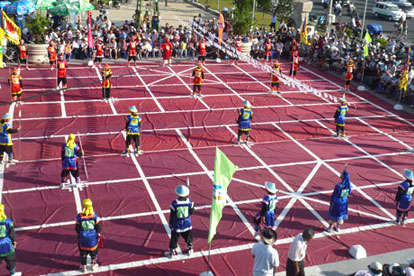
In human chess, however, the pieces are all people: 32 people in all. One side consists of 16 boys and the other of 16 girls. Each team wears a different colour.
The chessboard is marked by paint on flat ground. Village festivals usually use the yard in front of a communal house or pagoda or a nearby field. Organisers select players plus a referee well in advance. All should be children of families with a good reputation. The referee and the two generals should come from wealthier families so they can treat their players to food. As the selection finishes, the referee convenes the 32 people, describes the costumes, and tells each person how to move as a chess piece. Players may sit on chairs and wear hats if it is sunny. They either wear boards with the Chinese names of their pieces or carry sign poles with the characters. The generals wear traditional costumes. The two contestants who direct the pieces have their own seats outside the board.
 In contrast to some other games practiced at festivals, human chess is known for its quietude and delicacy.
In contrast to some other games practiced at festivals, human chess is known for its quietude and delicacy.
Source: www.vietnamtourism.com